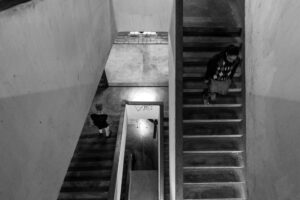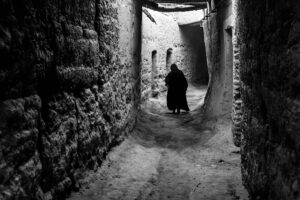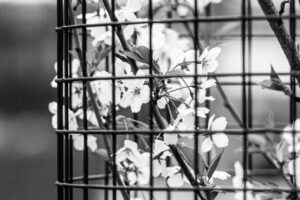In this blog post Laoighseach Ní Choistealbha discusses the sequence “Living in Hiroshima” by Anthony Glavin..

Anthony Glavin, professor of music in the Royal Irish Academy, pianist, and poet, was born in Dublin in 1945. The Gallery Press published his sole poetry collection, The Wrong Side of the Alps, in 1989. This collection contains the long sequence “Living in Hiroshima”, which discusses various aspects of twentieth-century history, with a particular focus on the ethical implications and the traumatic aftermath of the atomic bombing of Hiroshima of 6 August, 1945. The bombing of the city, an attempt by America to bring a decisive end to the war against Japan during World War II, led to the deaths of tens of thousands of residents of Hiroshima, the exact number remains unknown. It was the world’s first nuclear attack, and humankind was awakened to the new atomic age, in which the threat of total annihilation loomed large.
The sequence has an interesting publication history. The sequence first saw light in New Irish Writing in The Irish Press. Following this, four poems from the “Living in Hiroshima” sequence were published in Poetry Ireland Review (22/23) in 1988. This publication functioned as an illustration of the themes and scope of the sequence, which was published a year later in The Wrong Side of the Alps. This extended sequence was described in the collection’s blurb as ‘unfinished’, despite its length: fifty-eight individually titled short lyric poems, comprising 232 lines of text.
Poems from “Living In Hiroshima” were published in an anthology of short poems, The Hip Flask (2000), and in Dancing with Kitty Stobling: The Patrick Kavanagh Poetry Award Winners, 1971-2003 (2004). In 2006, Mark Granier, Glavin’s fellow poet and friend, submitted a new selection of twenty poems from ‘Living in Hiroshima’ on Glavin’s behalf, which were published in The Poetry Ireland Review (87). Glavin’s health condition, which had been worsening for some time by this point, led to his death in November 2006. In 2007, Granier made another selection of eleven poems from ‘Living in Hiroshima’ for Poetry Ireland Review (89), nine of which had never been previously published, ‘to give some further sense of the richness and uniqueness of [Glavin’s] unfinished sequence’ (2007: 31). In a blog post in 2016, Granier included further poems from the sequence, as well as elaborating on the ‘lucidity and density’ of Glavin’s work.
Despite the scope of “Living in Hiroshima”, Glavin’s work has attracted little critical attention, excepting a short analysis of the poem by scholar Irene de Angelis in The Japanese Effect in Contemporary Irish Poetry (2012). This short article will contribute to burgeoning research on Glavin’s work by providing a brief overview of the content of the sequence as published in The Wrong Side of the Alps (1989). Several notable poems from this publication will be discussed in order to reflect some of the quality and scope of the sequence, as well as to underline the depth of the poet’s ethical concerns regarding this period of history.

“Living in Hiroshima” is divided into three sub-sections: “Oblivion’s Throe”, comprising sixteen poems; “Ions”, with twenty-two poems; and “Half-Lives”, containing twenty poems. The focus of the sequence is the bombing of Hiroshima, its implications for humanity, and its effects upon the psyche of the speaker of the poem himself. The first section, “Oblivion’s Throe”, describes the moments directly before and after the bombing of Hiroshima. The fateful approach of the American B-29 bomber over Hiroshima is described in detail. The time of the moment of impact is precisely noted in the title of the fourth poem of the sequence, “Sky High” as the bomb falls to earth. The short sentences in the penultimate line of this poem increase the sense of trepidation before the ‘sky blurts open’:
B-san, lightened, screamed in a 60° dive To clear the 'All-Clear' delta, to watch and wait. The tail-gunner put on his special issue glasses. No-one knew quite what to expect. No one. 8.16 a.m. A fleeing Nazi skis across an Alpine glacier. Pius XII bows low to intone the Agnus Dei. Heartbeats. Lifetime. Seconds ticking away. The sky blurts open like a Morning Glory. (WSA: 9-16)
Also of note in the sequence are the gruesome descriptions of the bomb’s effect on the human being’s mind and body. The images used in the sequence comprise some of the most arresting war imagery in modern Irish poetry. The brutalized condition of the bombed Japanese civilians, over whose ruined bodies the survivors of the explosion must climb, is cast in stark contrast with the jubilant celebrations of the American troops who have unleashed the nuclear bomb upon them:
Airways On Tinian, the groundcrew were already icing beer, Oblivious of ion-dances in the atmosphere Creating havoc with the codes to Washington: ‘LITTLE BOY….’ – blort! crackle! – ‘….damage done’. (WSA: 73-80) Vertigo Heat-buckled girders. Alive with bodies. No choice. Fistfuls of skin and tissue slimed each palm, A squelch of something yellow where stepped-on eyes…. She sickened, steadied herself, continued to climb. (WSA: 101-104)
While “Oblivion’s Throe” and “Ions”, the first two sections of the poem, primarily describe the bombing of Hiroshima, “Half-Lives”, the final section, explores a number of other events of ethical concern from World War II. This section, for example, highlights the suffering of prisoners in the Nazi concentration camps of Buchenwald and Auschwitz, and Dwight D. Eisenhower’s arrival to liberate the Nordhausen camp in 1945. The speaker of the poem here is directly involved in the scene, as he is unsettled by the ‘leathery corpses’ of the Holocaust victims:
With Eisenhower at Nordhausen A pile of leathery corpses stacked like cordwood. Deep in, an eye, still blinking. I turned, sickened, Jostled a captured guard, backed off, and giggled. ‘Having trouble hating them?’ asked Eisenhower. (WSA: 177-180)
The increased diversity of topics in the section titled “Half-Lives” indicates perhaps the scope of future publications of the poem, something that is borne out in the other fragments of “Living in Hiroshima” printed later in Poetry Ireland Review. Another point of interest in this sequence is the traumatic effect that the events of World War II have on the speaker of the poem. Indeed, Glavin himself was greatly disturbed that his birth on 7th August 1945 occurred the day after the bombing of Hiroshima. Granier remarks: ‘his coming into the world coincided with an event that abruptly altered the world’s ‘‘historical velocity’’(Granier, 2007: 30). Glavin’s unsettled relationship with his imagined memory of the event itself appears to be expressed in several poems in the sequence, which refer to his trauma in terms of Freudian psychoanalysis, for example:
Metempsychosis A myth, according to my analyst - ‘Projective identification. An ego mechanism.’ But all these voices shrieking in my ear – If I write as I hear them, I’m their ghost. (WSA: 185-188)
Indeed, the sequence ends with the imagery of a Freudian psychoanalytical session, as the speaker of the poem reflects upon his trauma, looking at the ceiling above him in the classical supine pose: ‘My analyst sighs – no comment, he can wait…. / The ceiling flickers like a video screen’ (WSA: 231-232). The speaker’s deep trauma at the events of twentieth-century warfare is likely a reflection of Glavin’s own struggles with the reality of the world into which he was born – a world which had just witnessed the nuclear bombing of Hiroshima and the unveiling of the horrors of the Holocaust.
Glavin’s work, of which only a tiny fragment has been discussed here, is momentous in scope, despite its fragmented state. Glavin appears to allude to the sequence’s fragmentated state in a poem published in the final iteration of the sequence, in Poetry Ireland Review (89):
To Mine Own Self I’m in bits. I have written myself to pieces. There is in this aftersilence an aftersong And friends who ask what I’m working on. Bits, is all I can say, bits and pieces. (PIR: 29-32)
Such a sequence, concerning itself with the primary ethical issues of the twentieth century and their traumatic effects on the human psyche, deserves sustained critical analysis, alongside comparative studies with other literary texts about the bombing of Hiroshima. The ‘bits and pieces’ of Anthony Glavin’s ‘Living in Hiroshima’, surely merit unification, interpretation, and a long-overdue appraisal as a canonical text of the Irish literary corpus.
Works Cited
Glavin, A., 1989. The Wrong Side of the Alps. Loughcrew: The Gallery Press.
Glavin, A., 1988. ‘Four Poems from Living in Hiroshima’. Poetry Ireland Review (22/23), 15.
Glavin, A., 2006. ‘From Living in Hiroshima’. Poetry Ireland Review (87), 12-16.
Glavin, A., 2007. ‘From Living in Hiroshima’. Poetry Ireland Review (89), 32-35.
Granier, M., 2007. ‘Anthony Glavin: “Living in Hiroshima’’’, The Poetry Ireland Review (89), 30-31.
The author of this blog post would like to thank Mark Granier for his assistance. Poems are reprinted with the kind permission of The Gallery Press and, in the case of “To Mine Own Self”, Anthony Glavin’s Estate.





